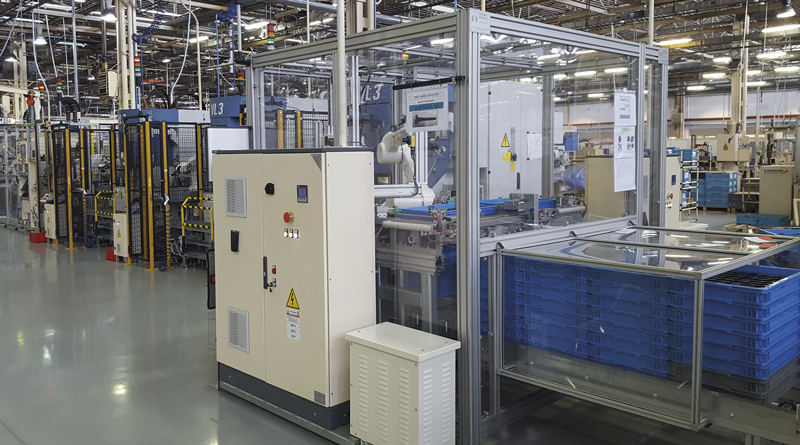Seven Robots for Five Workstations
Mainly engaged in machine tending operations, seven Denso six-axis robots, distributed in Italy by K.L.AI.N.robotics, are currently working at the factory of Denso Manufacturing Italia, a primary name in the production of components for the automotive sector, located in Abruzzo. Hexagon Engineering, a young company from the town of San Salvo, took care of both the electrical design as well as the integration of robots in production lines.
by Sebastiano Mainarda
Also due to the relaunch of the so-called Costa dei Trabocchi, which roughly corresponds to the part of the Adriatic coast included in the province of Chieti and is known, precisely, for the ancient wooden fishing structures on stilts, the Trabocchi, the town of San Salvo is a renowned tourist destination. Along with the tourism, however, the economy of San Salvo relies on the presence of some large production plants of multinational companies, generating, of course, some relevant satellite activities. One of these production sites is that of Denso Manufacturing Italia, belonging to one of the largest suppliers of components for the automotive sector in the world.
Currently, the activity of the San Salvo plant, which counts about a thousand employees, is primarily focused on the production and assembly of alternators, starter motors and small motors (electro-fans and windscreen wipers/rear wipers).
Automation enthusiasts
Talking about satellite activities, among the companies that collaborate with Denso Manufacturing Italia is Hexagon Engineering, based in San Salvo. A young and dynamic company, born from the passion for industrial automation, mainly working in the automotive sector but with some experience in the pharmaceutical and food industries. The high quality standards that Hexagon Engineering is able to guarantee have led the company to export machines abroad, in countries such as the United States, Germany, Belgium, Croatia, Bulgaria and Poland. Automation of complete assembly and testing lines; vision systems management; implementation of product monitoring and traceability systems; ordinary and extraordinary maintenance on plants and production lines; electrical or software design and commissioning of automation systems are just some of the activities provided by Hexagon Engineering.
Electrical design and robot integration in the production line
Precisely for the Denso Manufacturing Italia plant in San Salvo, Hexagon Engineering, and specifically Eng. Mirco Giuseppe, manage the automation of a line, made of five workstations, in the “Starter Slow Shaft” area, within a project shared with Denso Manufacturing Italia (Eng. Silvio Scopa) and, as for the properly mechanical side, with Teodoro Impianti (mechanical designer: Stefano Capone). “Specifically – says Mr Mirco Giuseppe from Hexagon Engineering – we dealt with the electrical design and construction of integrated automation panels and software design (PLC, HMI and robots) for the entire line, interfacing the CNC machines for part processing, especially the shafts”.
The first of the five stations has a connection with the previous station, from which it receives information about the compliance of the workpiece. Here the loading/unloading takes place on the machine that checks the external diameter finishing. A six-axis Denso robot picks up the workpiece from the existing line in a vertical position and also picks up the pieces from the buffer; then, the robot places the pieces to be processed over the placement in a horizontal position and also places the pieces on a buffer. A second Denso robot picks up the processed parts from the placement in a horizontal position and carries out three different deposit operations: in fact, it takes care of placing the processed pieces on the line in a vertical position, the faulted pieces and the piece to be controlled randomly by the operator.
Machine tending and control
The three following workstations carry out the loading and unloading of the pieces for turning operations. Another six-axis robot feeds independently three lathes, handling the shaft from the unloading of the previous machine to the belt of one of the three stations, depending on the signals coming from the lathes. There are three dedicated belts, one for a lathe, and each lathe is in turn fed by a robot that picks the shaft from the dedicated tape for machining and then places the shaft always on the same tape. The last station of the line carries out the automatic control and takes care of placing the finished shaft in a box. Here, another Denso robot takes the piece from one of the three previous workstations, places the piece for checking the presence of chips, picks up the controlled piece and then places the finished piece inside the box.
Higher performance thanks to the robots
A project of machine tending with quite a high automation rate, therefore, in which the contribution of the robots turned out to be extremely important, as told by Mirco Giuseppe. “In designing the line, together with the technicians from Denso and Teodoro Impianti, we agreed to use seven robots for machine tending. In fact, the workstations are often implemented according to production, quality or new types of products to be processed. By using the robots we can achieve higher performance, reduce cycle time and be ready for changes of trajectories in case of new processes. We are generally capable to perform such interventions rather quickly, without any mechanical involvement, but through software implementations. Similarly, the choice of the type of robot (all of them are six-axis ones) was taken because of the type of piece to be processed as well as the movements and machining (rotation, picking or placing within a given space) involving the piece along the whole cycle”.
As for the choice of the robot manufacturer, the partnership that Hexagon Engineering has established with K.L.AI.N.robotics, distributor of Denso robots on the Italian market, has greatly counted. As told by the Abruzzo company, the relationship with K.L.AI.N.robotics dates back to a few years ago, and precisely when the collaboration with Denso Manufacturing Italia started. It was then possible to find solutions that, over time, have been used in several applications, not only in the automotive industry.

